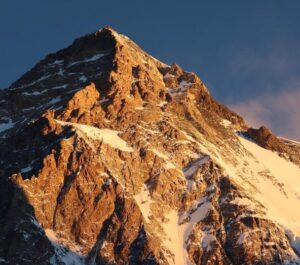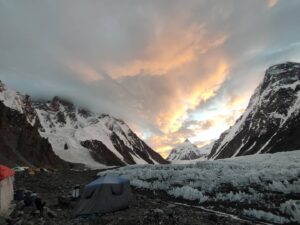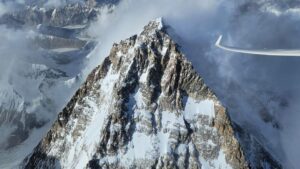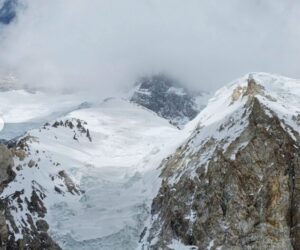Yesterday we shared some of climber and expedition doctor Robert Szymczak‘s research about how different it is to climb an 8,000m peak in winter.
Szymczak’s report comes less than a year after the first winter ascent of K2. Meanwhile, in the days ahead, a handful of climbers prepare to tackle Everest, K2, Manaslu, and likely Cho Oyu and Nanga Parbat. Here, Szymczak gives his perspective on winter expeditions past and present and suggests how the future of 8,000m winter climbing may evolve.
Perceived altitude
How different is it to climb winter K2 with or without O2?
The main difference is the perceived altitude, which decreases with the use of supplemental oxygen. The perceived altitude depends on the oxygen flow a climber uses, the level of activity, and the actual altitude. For example, a mountaineer at 8,500m who uses the standard amount of oxygen (four litres per minute) perceives the altitude 750m lower (7,750m) when climbing as hard as he can, and feels 2,250m lower (6,250m) when resting.
When the oxygen flow increases to eight litres per minute, the perceived altitude decreases by 1,250m at the maximal level of activity to 7,250m, and more than 2,500m at rest to 6,000m. [Readers who want to do a deep dive into the source material for such numbers can check this paper.]

K2 in winter: Winds are rarely less than gale force on the summit.
Supplemental oxygen reduces the risk of acute altitude illness, hypothermia, and frostbite. It lowers acclimatization requirements and gives a better physical and neuropsychological performance at extreme altitudes. This allows faster climbing, better decision making, a shorter time for a summit push, and less chance of having to bivouac on the way down.
So far, only one person has climbed Everest in winter without supplemental oxygen: Ang Rita Sherpa in December 1987. Those on oxygen have made the other 14 ascents. Climbers survived the most extreme conditions ever experienced on Everest thanks to supplemental oxygen. Oxygen increases the chances of both survival and success. [Another Szymczak paper backs up these conclusions here.]
Disadvantages of O2
Are there any disadvantages to using O2 in winter high-altitude climbing?
The main disadvantage is the huge number of oxygen cylinders needed at higher camps. From the medical point of view, the main concern is the risk of a sudden lack of supplemental oxygen and its dramatic, deadly consequences for an insufficiently acclimatized climber in the Death Zone. Wielicki and Cichy were the first to climb Everest in winter in February 1980. They used oxygen. They unexpectedly ran out of oxygen at the South Summit (8,748m) while descending. Both suddenly experienced visual disturbances, including vision loss, which fortunately disappeared. They were then able to continue their descent.
What happens when a team includes some climbers using O2 and others not? Could they summit at the same time, or even on the same day?
[Such] cooperation is possible during one expedition. A successful summit push depends on many components, including choosing and fixing the route, carrying equipment, food, and emergency gear. Climbers using oxygen can do the hardest work, [enabling] those climbing without oxygen to reach the summit at a similar speed and time as the “oxygen group”. The whole team can work for one leader, as happens during cycling races.
Few, short weather windows
The next expedition on K2 is a commercial venture, in which a strong Sherpa team will support client Grace Tseng, with everyone on oxygen. Do you think they have realistic chances for success?
Using oxygen will not change the weather. The conditions on the summit of K2 in winter are dramatically worse than in summer on K2 and spring on Everest. The weather windows are scarce, with just a few 12-hour periods in three months when the wind is below 55kph on the summit. Let’s not forget that during the seven winter K2 expeditions between 1987 and 2019, the highest altitude anyone reached was 7,650m!
The use of oxygen increases the chances of success because acclimatization requirements are lower, and oxygen allows faster climbing, which may lead to more effective use of the rare weather windows. [Expeditions] equipped with sufficient oxygen have a better but still very low chance of summiting K2 in winter. The primary problem is the weather. Second but still important is having to carry so many oxygen cylinders to the higher camps.

Grace Tseng of Taiwan trains for winter K2 in a hypobaric chamber. Photo: Grace Tseng
Future possibilities
If commercial expeditions to winter 8,000’ers become the norm, do you think this will help or harm individual climbers who are going without O2?
The physiological challenge for the climbers not using oxygen will stay the same. But a higher number of expeditions, especially commercial ones on the most popular routes, will facilitate the logistics of climbing (fixed ropes) and will increase safety (more climbers to help, more oxygen for emergencies).

Dhaulagiri 2008. Alex Txikon in the background. Photo: Robert Szymczak
Do you think it is possible to climb K2 in winter if no one in the team uses O2?
Yes.
How about Jost Kobusch’s upcoming Everest expedition? He has been acclimatizing on 6,000’ers in the Annapurna area but has chosen to base himself in Lobuche rather than on the glacier.
Kobusch’s method of acclimatization is correct. As I mentioned previously, climbing other peaks just before winter arrives is a very good idea.
Regarding those so-called yo-yo tactics, the UIAA advises mountaineers not to overnight at altitude after their first ascent. The climber who has summited a 6,000m peak should rest in Base Camp. Then he will be ready to sleep at 6,000m and try to touch 7,000m on the next rotation. The climber who has touched 7,000m is ready (again, after resting in Base Camp) to sleep at that altitude and try to reach 8,000m on the next rotation.

Jost Kobusch on the summit of Purbung two weeks ago. Photo: Nicolas Scheidteiler
Maybe only highlanders can go no-O2 in winter
In Kobusch’s case, recovery in Lobuche village will be better, thanks to its lower altitude and greater comfort. A lodge is a better accommodation than Base Camp at a higher altitude on the Khumbu Glacier. This difference will be particularly noticeable in winter for a small expedition.
What are you thoughts about the future of winter 8,000m climbing? Will it go entirely commercial or will the trend fizzle out in a couple of years?
The chance to be the first “summit conquerors” can motivate even whole nations to organize expeditions. Since all 8,000’ers have been climbed without oxygen, both in the normal season and in winter, the motivation is definitely much smaller. Taking so much risk in order to be second is harder to accept.

Climbing winter Broad Peak in 2008-09. Photo: Robert Szymczak
It is significant that so far, highlanders have made the only winter ascents of Everest and K2 without oxygen: Ang Rita Sherpa on Everest, and the Magar Nirmal Purja on K2. Tibetans and populations with Tibetan ancestry (Nepali highlanders: Sherpa, Rai, Magar, Tamang; as well as Pakistani highlanders, the Balti) have adapted to environmental hypoxia for hundreds of generations. In the case of Tibetans, about 500 generations. Whether a lowlander can survive a no-O2 ascent of Everest or K2 in winter remains unanswered so far.
I suppose that if there are no successes on commercial winter expeditions to 8,000m peaks, i.e. no summits, which is most likely, the trend will die.






